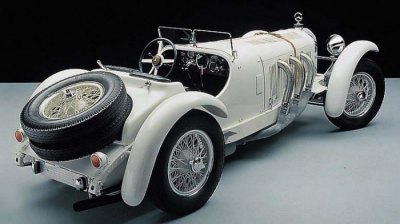 Whenever talk about
Mercedes' motorsport success, most remember the Silver Arrows that
dominated the motorsport world in the late 1930s. However, well before
that, there was a line of White Arrows emerged in 1927, winning many
hillclimb events, two Nurburgring GPs (1928 & 31), one Irish GP
(1930) and the most challenging road race in the world, Mille Migila
(1931). It broke the domination by Italian and French sports car makers
and gave German the first taste of motorsport success. That was the
Mercedes S / SS / SSK / SSKL series.
The family was designed by Ferdinand Porsche when he was serving as technical director of Daimler, just before founding his own consultant company. Work was started based on the existing Mercedes 630K, which was a luxury touring car powered by a 6.3-liter supercharged straight-6. Porsche gave the new S (Sport) model a lower chassis for better handling and bored out the engine to 6.8 liters, taking its supercharged horsepower to 180. As before, the Roots-type supercharger was engaged by flooring down the throttle, otherwise the engine ran off-boost and produced up to 120 hp. Therefore, the S was officially called 26/120/180S, where the numbers represented its tax horsepower, off-boost horsepower and supercharged horsepower respectively. Another superior feature to the 630K was a 4-speed gearbox, which could take the car to 110 mph. One year later, the S was improved to SS (Super Sport). It was slightly lighter and more powerful, the latter thanks to upgrading its engine to 7.1-liter and 200hp. However, neither these cars were exactly sports cars, let alone "super sport". They were actually high-speed touring cars, preserving the same sturdiness, over-built bodywork and high quality standards as other Mercedes cars. As a result, they tipped the scale at 2 tons. The fact that legendary driver Rudolf Caracciola won the 1928 Nurburgring GP with the SS was more down to his driving skill and the robustness of the car rather than its speed.  Fortunately, Mercedes did not take long to build a really
motorsport-oriented version, SSK, where K represented German word Kurz
(short). Its wheelbase was shortened by a massive 450 mm, and a lean
bodywork was fitted to save weight. A bigger supercharger boosted
output to 225 hp and top speed to a claimed 120mph, although British
magazine Motor managed only 106 mph in its road test. The SSK was
finally a sports car. Though neither a real Grand Prix car like Bugatti
T35 nor an endurance car like Bentley Speed Six, it won many road and
hillclimb races, plus the 1930 Irish GP. Only 31 cars were built, so it
is highly valuable.
The last version of the series was a pure race car, SSKL, where L denotes light. Its ladder frame was further lightened by drilling holes, and the engine was boosted to an astonishing 300 hp, though it required special racing fuel (a mixture of gasoline and benzol) to avoid overheating. Only 6 cars were built, one of them gave Caracciola the trophies of 1931 German GP and Mille Miglia. That was also its last shinning moment. The White Arrows was one of the most successful sports cars in the 1920s, but facing the newer and much lighter Alfa Romeo 8C2300, its handling and braking became hopelessly outdated. Silver Arrows would strike back in the mid-1930s, but that was another story, and those purpose-built race cars would be out of the scope of our classic car archive. |